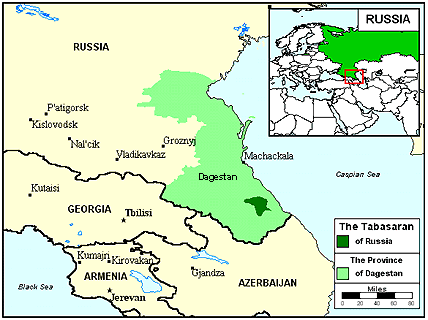|
|
Prayer Profile
The Tabasaran of Russia
![[IMAGE]](../images2/0368.jpg) The 93,600 Tabasaran live in Russia, in southern Daghestan, one of the former Soviet Republics. They inhabit the areas along the upper Rubas-chai and Chirakh-chai Rivers, north of the Samur valley. In Daghestan, they compose nearly 5% of the population. Ethnically, they are very united, having resisted pressure from foreign rulers for centuries.
The 93,600 Tabasaran live in Russia, in southern Daghestan, one of the former Soviet Republics. They inhabit the areas along the upper Rubas-chai and Chirakh-chai Rivers, north of the Samur valley. In Daghestan, they compose nearly 5% of the population. Ethnically, they are very united, having resisted pressure from foreign rulers for centuries.
The Tabasaran speak several languages. Their native tongue is called Tabasarantsy; however, Azerbaijani, Lezgin, and Russian are also widely spoken. The development of writing in the Tabasaran area came with the spread of Islam, as first the Arabic language and later the Arabic script were introduced.
Most Tabasaran live in rather mountainous areas, but some have moved to the lowlands and the foothills. The climate of their territory is moderate to warm, with fairly mild winters, hot summers, and rainy and humid autumns. The mountains are thus used as summer pastures, and the plateaus, as winter pastures.
What are their lives like?
The Tabasaran were traditionally divided into clan groups called tukhums. These clans included several households related to a common male ancestor. Today, the clan system remains intact, and vendettas (blood feuds) still occur. Traditionally, marriages were arranged by not only the immediate family but also a wide circle of relatives. The couple was usually young (15 or 16) and came from the same social and economic level. The newlyweds often lived with the groom's family. Until the early twentieth century, extended families were common, consisting of even three or four generations. Now, the nuclear family is the norm.
Traditionally, every village had a gathering place (usually near the blacksmith's shop or mosque) where village meetings where held. However, during the Soviet years, new areas with special buildings for social or cultural activities were sometimes built next to the villages. New villages arose in the lowlands, with straight streets, running water, and electricity.
Traditional Tabasaran houses were usually two-storied stone dwellings. In mountain areas, houses often had three or four stories. During Soviet times, modern two-storied houses were built with large windows, shingled or metal roofs, and yards; but traditional floor plans and decorations were kept.
The Tabasaran economy was originally based on growing crops such as wheat, rye, millet, buckwheat, beans, and maize; raising livestock; and growing grapes for wine. Cows, bulls, and steers were kept in the foothills and sheep were kept in the higher areas. The typical diet included grains, beans, wild herbs, meat, and milk. The main beverage was a buttermilk drink. Some mildly alcoholic drinks were also popular. Today, the diet is basically the same but with more variety, and includes vegetables and preserves.
The Tabasaran often held trades as embroiderers, rug weavers, wood crafters, carvers of wood and stone, coppersmiths, silversmiths, felt makers, tanners, and weavers of wool, flax, and cotton. Today, only rug weaving, embroidering, woodworking, and silver- and coppersmithing are still practiced. In Soviet times, the craftsmen united into cooperative groups, but today many work in neighboring districts.
What are their beliefs?
The Tabasaran remain 100% Muslim, as they have been since the Arab conquests of the ninth century. Before that time, Christian elements were part of their culture. Today, every village has a mosque, and larger villages may have more than one, often with Islamic schools nearby. Nevertheless, remnants of their pre-Islamic beliefs are still evident. There are cults associated with fire, stones, trees, and caves. Traces of earth, sun, sky, and moon worship still exist, as well practices that include worshipping the graves of holy men, using magic, and performing rituals to bring sunshine or rain. Many also believe in protective deities and spirits.
What are their needs?
With no known believers among them, the Tabasaran are in desperate need of a viable Christian witness. Prayer, laborers, and evangelistic tools are urgently needed if the Tabasaran are to come to know Jesus.
Prayer Points
- Ask the Lord of the harvest to send forth laborers into Russia who will share the love of Christ with the Tabasaran.
- Pray that Christian radio broadcasts, evangelical literature, and the Jesus film will be made available to the Tabasaran.
- Ask the Lord to raise up qualified linguists who will translate the Bible into Tabasarantsy.
- Pray that God will reveal Himself to the Tabasaran through dreams and visions.
- Take authority over the spiritual principalities and powers that are keeping the Tabasaran bound.
- Ask God to raise up prayer warriors who will intercede for the Tabasaran.
- Pray that strong local churches will be raised up among the Tabasaran.

Statistics
Latest estimates from the World Evangelization Research Center.
THE PEOPLE
- People name: Tabasaran
- Country: Russia
- Their language: Tabasarantsy
- Population:
- Largest religion:
- Christian: 0%
- Church members: 0
- Scriptures in their own language: None
- Jesus Film in their own language: None
- Christian broadcasts in their own language: None
- Mission agencies working among this people: 0
- Persons who have heard the Gospel: 3,700 (4%)
- Persons who have never heard the Gospel: 89,900 (96%)
THEIR COUNTRY
- Country: Russia
- Population:
- Major peoples in size order:
- Major religions:
- Number of denominations: 50
© Copyright 1997
Bethany World Prayer Center
This profile may be copied and distributed without obtaining permission
as long as it is not altered, bound, published
or used for profit purposes.
![[HOME BUTTON]](../graphics/home.jpg)
![[CALENDAR BUTTON]](../graphics/calico.jpg)
![[LIST BUTTON]](../graphics/listico.jpg)
[Home]
[Calendar]
[Country List]
|